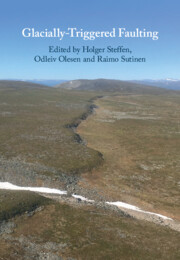Book contents
- Glacially-Triggered Faulting
- Glacially-Triggered Faulting
- Copyright page
- Contents
- Figures
- Tables
- Contributors
- Preface
- Part I Introduction
- Part II Methods and Techniques for Fault Identification and Dating
- Part III Glacially Triggered Faulting in the Fennoscandian Shield
- Part IV Glacially Triggered Faulting at the Edge and in the Periphery of the Fennoscandian Shield
- Part V Glacially Triggered Faulting Outside Europe
- 19 The Search for Glacially Induced Faults in Eastern Canada
- 20 Glacially Induced Faulting in Alaska
- 21 Indications on Glacially Triggered Faulting in Polar Areas
- Part VI Modelling of Glacially Induced Faults and Stress
- Part VII Outlook
- Index
- References
19 - The Search for Glacially Induced Faults in Eastern Canada
from Part V - Glacially Triggered Faulting Outside Europe
Published online by Cambridge University Press: 02 December 2021
- Glacially-Triggered Faulting
- Glacially-Triggered Faulting
- Copyright page
- Contents
- Figures
- Tables
- Contributors
- Preface
- Part I Introduction
- Part II Methods and Techniques for Fault Identification and Dating
- Part III Glacially Triggered Faulting in the Fennoscandian Shield
- Part IV Glacially Triggered Faulting at the Edge and in the Periphery of the Fennoscandian Shield
- Part V Glacially Triggered Faulting Outside Europe
- 19 The Search for Glacially Induced Faults in Eastern Canada
- 20 Glacially Induced Faulting in Alaska
- 21 Indications on Glacially Triggered Faulting in Polar Areas
- Part VI Modelling of Glacially Induced Faults and Stress
- Part VII Outlook
- Index
- References
Summary
There is abundant evidence for high levels of seismic activity during deglaciation of Eastern Canada, suggesting that the seismic response of Eastern Canada to deglaciation is analogous to Fennoscandia, where numerous glacially induced faults have been confirmed. However, the Canadian record of glacially induced faults is scant. The two probable glacially induced faults that are described are few compared to the 100+ surface ruptures that are expected on statistical grounds. Alternative explanations to account for the small number of known ruptures are provided together with an interpretation of certain normal faulting that has been observed in glaciolacustrine sediments. It is recommended that the interpretation of prospective glacially induced fault features utilize a sceptical approach employing judgemental scales that reflect data limitations and associated uncertainties.
Keywords
- Type
- Chapter
- Information
- Glacially-Triggered Faulting , pp. 341 - 352Publisher: Cambridge University PressPrint publication year: 2021
References
- 3
- Cited by

